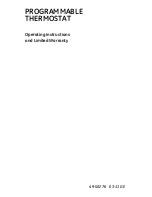
Step 6
Rotate the adjustment knob until the desired set temperature is
displayed by the indicator. See Figure 11.
Step 7
Periodically ensure all field wiring connections are secure and
undamaged.
CAUTION
CAUTION.
The thermostat must not be modified in
any way. It is factory calibrated and cannot be
recalibrated in the field.
Step 3
Wire load switch relay as per Figure 7 for resistive heating load
and Figure 8 for pilot duty load. Use correct rated wire depending
on voltage used. Use copper wire rated for 90°C connections.
For heating applications, attach wire to N.O. terminal. See Figure 9.
For cooling applications attach wire to N.C. terminal. See Figure 10.
Step 4
Install the cover using the 4 bolts supplied and tighten.
Step 5
Fill any unused conduit opening using plug supplied.
Resistive Heating Load
240V, 20 A Max.
Heating
Load
Cooling
Load
N.C.
Direct
Acting
N.O.
Reverse
Acting
Load
Switching
Relay
Neutral
Line 240 VAC Max. 50/60 Hz
Figure 8
Figure 9
Figure 10
N.O.
Terminal
Figure 7
Heating
Load
Cooling
Load
N.C.
Direct
Acting
N.O.
Reverse
Acting
Cooling Load
Heating Load
Heating
Contactor
Cooling
Contactor
Control Coil
275 VA Max.
Control Coil
470 VA Max.
Load
Switching
Relay
Heating
Load
Cooling
Load
N.C.
Direct
Acting
N.O.
Reverse
Acting
Load
Switching
Relay
C
Common
C
Common
Neutral
Cooling
Load Power
Lines
Pilot Duty Line
24, 120, or 240 VAC 50/60 Hz
Pilot Duty Line
24, 120, or 240 VAC 50/60 Hz
Neutral
Heating
Load Power
Lines
Pilot Duty Cooling Load
Pilot Duty Heating Load
N.C.
Terminal
Temperature indicator
Figure 11






















